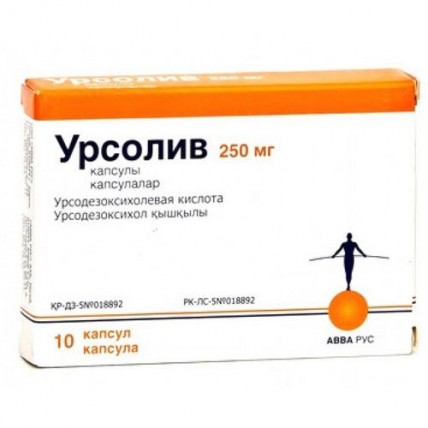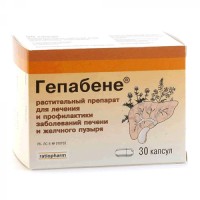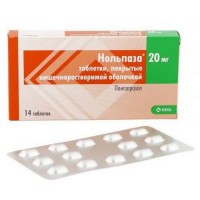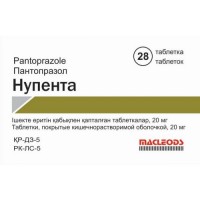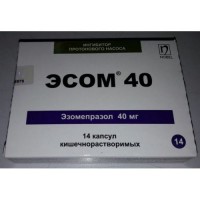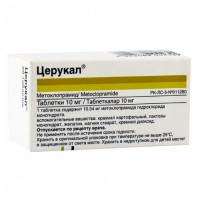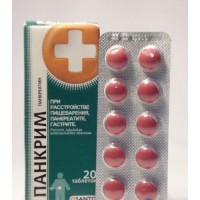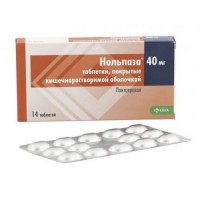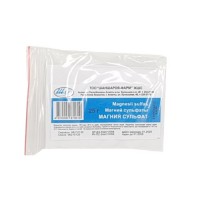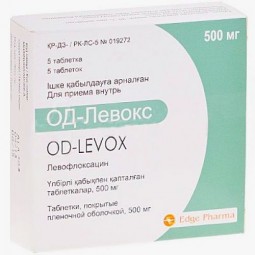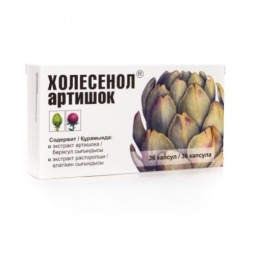Ursol 10s 250 mg capsules
- $9.30
The instruction for medical use of Ursoliv Torgovoye medicine a name of Ursoliv the International unlicensed name Ursodezoksikholevaya acid the Dosage form of the Capsule of 250 mg Structure One capsule contains active agent - ursodezoksikholevy acid of 250 mg, excipients - lactulose, cellulose microcrystalline, povidone low-molecular, magnesium stearate, talc, structure of a cover of the capsule - gelatin, the titan dioxide (E171), an azoruby (E122). The description Solid gelatin capsules No. 00 with the white body and a pink cover. Contents of capsules – the granulated powder of white or almost white color. Pharmacotherapeutic group Drugs for treatment of diseases of a liver and biliary tract. Drugs of bile acids. The code of automatic telephone exchange A05AA02 the Pharmacological UDHK Pharmacokinetics properties is absorbed in a small intestine (about 90%), at the same time the maximum concentration (Cmax) in blood plasma at administration of drug inside in a dose of 250 mg makes about 3.3 mkg/ml, time of achievement of the maximum concentration – about 2 hours. Linking with proteins of plasma of not conjugated UDHK at healthy people makes not less than 70%. Gets through a placental barrier. At systematic reception in doses of 13-15 mg/kg/days UDHK becomes the main bile acid in serum and makes from 30 to 50% of the general content of bile acids in blood. The therapeutic effect of drug depends on concentration of UDHK in bile. Metabolizes in a liver with transformation into taurinovy and glycine conjugates which cosecrete in bile. About 50-70% of the dose of drug accepted inside are removed with bile. Removal with urine does not exceed 1%. The insignificant quantity of UDHK which is not soaked up after oral administration comes to a large intestine where is exposed to splitting by bacteria (7 dehydroxylation), the formed lithocholic acid partially is soaked up from a large intestine, sulphated in a liver and quickly removed in the form of a sulfolitokholilglitsinovy or sulfolitokholiltaurinovy conjugant. The pharmacodynamics of Ursoliv - renders hepatoprotective, bile-expelling, cholelitholytic, hypolipidemic, gipokholesterinemichesky and some immunomodulatory action. In the researches in vitro it is shown that ursodezoksikholevy acid (UDHK) has direct tire-tread effect on cells of a liver and reduces hepatotoxicity of hydrophobic salts of bile acids. The main effects of UDHK on exchange of cholesterol include: decrease in secretion of cholesterol, reduction of its intestinal absorption and stimulation of an exit of cholesterol from cholesteric stones in bile. UDHK, braking GMK-KoA-reduktazu, renders also moderate overwhelming effect on synthesis of cholesterol in a liver, increases solubility of cholesterol in a bile-excreting system. Causes partial or full dissolution of cholesteric gallstones at enteral use, reduces bile saturation cholesterol. Stimulates education and biliation, accelerates removal of toxic bile acids through intestines. At oral administration UDHK share in a common pool of bile acids considerably increases, UDHK competes with other bile acids in the course of absorption in a small intestine and also at penetration through a hepatocyte membrane that leads to reduction of absorption of toxic bile acids in intestines and receipts them in a liver, preventing their cytopathic action. Reduces a bile litogennost, increases in it concentration of bile acids, causes strengthening of gastric and pancreatic secretion, enhances activity of a lipase, has hypoglycemic effect. Influences immunological reactions, reducing a pathological expression of antigens of the main complex of histocompatability of HLA І on hepatocytes and HLA II on holangiotsita, suppresses products of interleukin 2, reduces quantity of eosinophils. Indications - primary biliary cirrhosis in the absence of signs of a decompensation (symptomatic therapy) - dissolution of small and average cholesteric stones at the functioning gall bladder - a biliary reflux gastritis the Route of administration and doses Inside. Dissolution of cholesteric gallstones of the Capsule is accepted in the evening, before going to bed, without chewing and washing down with a small amount of liquid. About 10 mg on 1 kg of body weight daily that corresponds: To 2 capsules of the drug Ursoliv patients with body weight to 60 kg, to 3 capsules of the drug Ursoliv at patients with body weight to 80 kg, to 4 capsules of the drug Ursoliv at patients with body weight to 100 kg, to 5 capsules of the drug Ursoliv at patients with body weight over 100 kg, Duration of treatment have 6 - 12 months. For prevention of repeated formation of stones the administration of drug within several more months after dissolution of stones is recommended. Symptomatic treatment of primary biliary cirrhosis the Daily dose depends on body weight and makes from 2 to 6 capsules (from about 10 to 15 mg of ursodeoksikholevy acid on 1 kg of body weight). The drug is taken with food, washing down with enough water. The following mode of use is recommended: Body weight the Daily dose in the Morning in the Afternoon in the Evening of 34-50 kg 2 capsules 1 - 1 51-65 kg 3 capsules 1 1 1 66-85 of kg 4 capsules 1 1 2 86-110 of kg of 5 capsules 1 2 2 Over 110 kg of 6 capsules 2 2 2 For treatment biliary a reflux gastritis On 1 capsule once a day before going to bed. A course of treatment - from 10-14 days to 6 months, if necessary - up to 2 years. Side effects Are possible - nausea, vomiting, pain in epigastric area and the right of nodreberye, the constipation, tranzitorny increase in activity of hepatic transaminases - at treatment of primary biliary cirrhosis can be observed a passing decompensation of cirrhosis which disappears after drug withdrawal Seldom - diarrhea (can be dose-dependent), calcination of gallstones, Other - a headache, an indisposition, myalgias, dizziness - allergic reactions (skin itching, a small tortoiseshell, a Quincke's disease) - exacerbation of earlier being available psoriasis, the Contraindication alopecia - hypersensitivity to drug - the size of cholesteric stones in a gall bladder more than 20 mm - existence X-ray contrast (with the high content of calcium) stones of a gall bladder and general bile duct - an atrophy of a gall bladder in cholelithiasis, a nonfunctioning gall bladder, obstruction of biliary tract - acute inflammatory diseases of a gall bladder, bile ducts and intestines - cirrhosis in a decompensation stage - the profound liver and renal failure - pancreatitis (active phase) - pregnancy and the period of a lactation - adults with body weight to 34 kg (for this dosage form) - children's and teenage age up to 18 years Medicinal interactions At combined use the antacids containing aluminum, and ion-exchange resins (Colestyraminum) reduce absorption of UDHK. At simultaneous use, hypolipidemic medicines (especially Clofibratum), are oestrogenic, Neomycinum or progestogens (oral contraceptives) increase bile saturation by cholesterol and can reduce ability of ursodezoksikholevy acid to dissolve cholesteric gallstones. At simultaneous use UDHK can increase cyclosporine absorption. Special instructions For dissolution of gallstones of UDHK concrements have to be cholesteric (not X-ray contrast), no more than 15-20 mm in size. At the same time the gall bladder has to remain functional, and the passability vesical and the general bilious channels has to be kept. When assigning for the purpose of dissolution of gallstones it is necessary monthly, and then - each 3 months to carry out biochemical analysis of blood for determination of activity of hepatic transaminases, alkaline phosphatase, gamma glutamiltranspeptidazy and also concentration of bilirubin. At preservation of the raised indicators, drug should be cancelled. For control of efficiency of treatment it is recommended each 6 months. to carry out radiological and ultrasound examination of biliary tract. At calcification of gallstones, disturbance of sokratitelny ability of a gall bladder or frequent attacks of bilious colic the treatment should be stopped. If within 6-12 months after the beginning of therapy of partial dissolution of concrements did not occur, it is improbable that treatment will be effective. Detection during treatment of not visualized gall bladder is the certificate that full dissolution of concrements did not happen, and treatment should be stopped. After full dissolution of stones, for an exception of a recurrence, it is recommended to continue use of ursodezoksikholevy acid, within 3 months. Features of influence of medicine on ability to run the vehicle or potentially dangerous mechanisms. Drug has no negative impact on ability to run vehicles, and/or other mechanisms. Overdose Cases of overdose of UDHK are not described so far. The form of release and packing of the Capsule of 250 mg On 10 capsules place in blister strip packaging from a film of polyvinylchloride and aluminum foil or from a soft foil of aluminum and aluminum rigid foil. On 1, 3, 5 blister strip packagings together with the instruction for medical use in the state and Russian languages place in a pack from cardboard. To Store storage conditions in the place protected from moisture and light at a temperature not higher than 25 wasps. To store out of children's reach! A period of storage 4 years not to apply after an expiration date Prescription status According to the prescription JSC AVVA RUS Producer, Russia, 610044 Kirov, Luganskaya St., 53A, ph.: (8332) 53-60-11 Owner of the registration certificate / JSC AVVA RUS producer, Russia 121614, Moscow, Krylatskie Holmy St., 30, building 9, ph.: (495) 956-75-54
To develop
To develop
